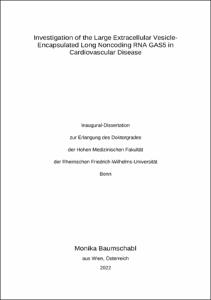Investigation of the Large Extracellular Vesicle-Encapsulated Long Noncoding RNA GAS5 in Cardiovascular Disease

Investigation of the Large Extracellular Vesicle-Encapsulated Long Noncoding RNA GAS5 in Cardiovascular Disease

| dc.contributor.advisor | Jansen, Felix | |
| dc.contributor.author | Baumschabl, Monika | |
| dc.date.accessioned | 2022-11-07T10:07:31Z | |
| dc.date.available | 2022-11-07T10:07:31Z | |
| dc.date.issued | 07.11.2022 | |
| dc.identifier.uri | https://hdl.handle.net/20.500.11811/10396 | |
| dc.description.abstract | In this study, we aimed to investigate whether an upregulated expression of GAS5 in patients with CADs causes alterations of the biological functions of ECs. Furthermore, we investigated the impact of large-EV-bound GAS5 on the integrity of recipient cells. Towards this goal, loss-of-function experiments with GAS5 in ECs resulted in significantly diminished cell viability, an elevated release of LDH, and increased activity of several caspases. Furthermore, endothelial network formation, proliferation, and migration were impaired upon depletion of GAS5. To evaluate the changes mediated by large-EV-bound GAS5 in RCs, EVs were collected from the supernatant and the uptake was visualized by labeling the EVs with PKH67 (a cell-membrane dye). To test the hypothesis that EV-incorporated GAS5 has an influence on recipient cells, we performed several in vitro functional experiments with ECs (tube formation, angiogenic sprouting, migration, proliferation, apoptosis, etc.) and confirmed that GAS5 is an important regulator of these functions. In vitro stimulation of ECs with pro-inflammatory factors like TNF-α (tumor necrosis factor alfa) and ox-LDL (oxidized low-density lipoprotein) showed a significant upregulation of GAS5 expression, in a dose-dependent manner. PCR analysis revealed a relationship between GAS5 and NF-κB (nuclear factor kappa light-chain enhancer of activated B cells), and western blot displayed that there is an upregulation of NF-κB expression upon silencing GAS5. In summary, our study provided evidence that in vitro stimulation of ECs with ox-LDL and TNF-α also results in an increased level of GAS5. Several in vitro loss-of-function assays revealed an important role for GAS5 and large-EV-bound GAS5 altered these same functions upon incorporation into the RC. PCR-based analysis and western blot both indicated that these changes are mediated by an NF-κB dependent mechanism. | en |
| dc.language.iso | eng | |
| dc.rights | In Copyright | |
| dc.rights.uri | http://rightsstatements.org/vocab/InC/1.0/ | |
| dc.subject.ddc | 610 Medizin, Gesundheit | |
| dc.title | Investigation of the Large Extracellular Vesicle-Encapsulated Long Noncoding RNA GAS5 in Cardiovascular Disease | |
| dc.type | Dissertation oder Habilitation | |
| dc.publisher.name | Universitäts- und Landesbibliothek Bonn | |
| dc.publisher.location | Bonn | |
| dc.rights.accessRights | openAccess | |
| dc.identifier.urn | https://nbn-resolving.org/urn:nbn:de:hbz:5-68596 | |
| ulbbn.pubtype | Erstveröffentlichung | |
| ulbbnediss.affiliation.name | Rheinische Friedrich-Wilhelms-Universität Bonn | |
| ulbbnediss.affiliation.location | Bonn | |
| ulbbnediss.thesis.level | Dissertation | |
| ulbbnediss.dissID | 6859 | |
| ulbbnediss.date.accepted | 06.10.2022 | |
| ulbbnediss.institute | Medizinische Fakultät / Kliniken : Medizinische Klinik und Poliklinik II - Kardiologie, Angiologie, Pneumologie und Internistische Intensivmedizin | |
| ulbbnediss.fakultaet | Medizinische Fakultät | |
| dc.contributor.coReferee | Schmidt-Wolf, Ingo G. H. | |
| ulbbnediss.contributor.gnd | 1289097313 |
Dateien zu dieser Ressource
Das Dokument erscheint in:
-
E-Dissertationen (1938)




